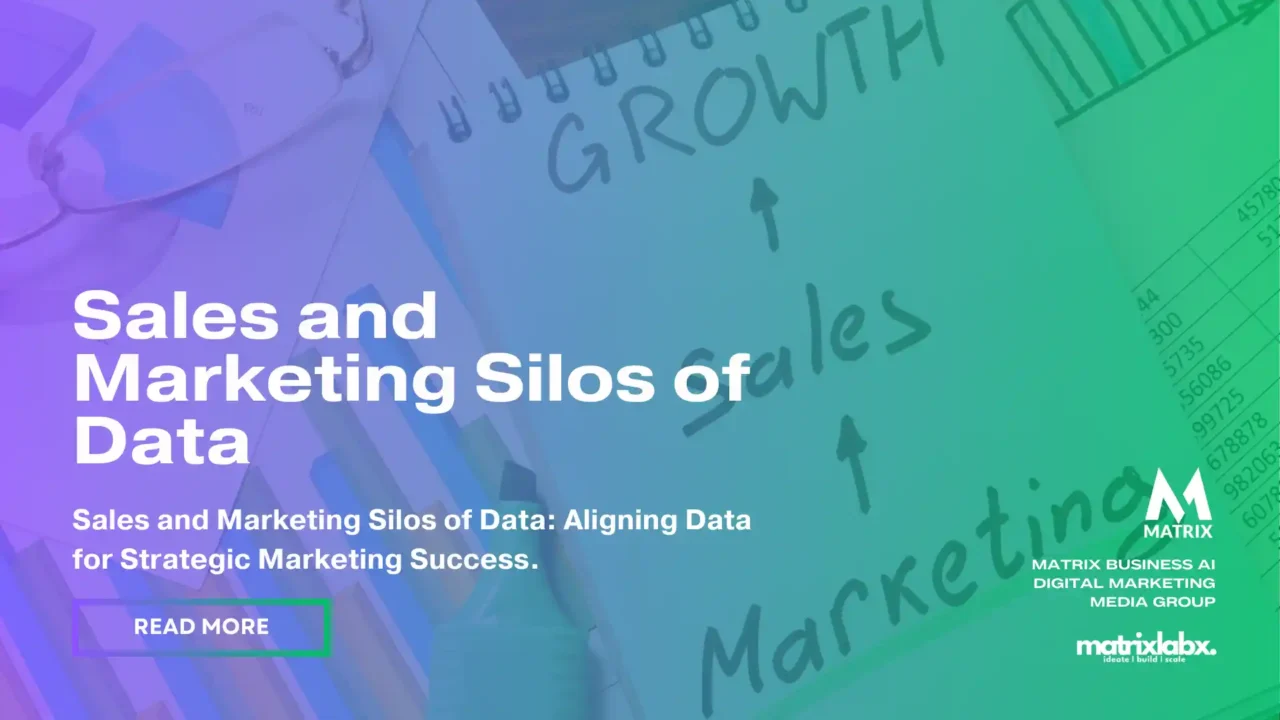Sales and Marketing Silos of Data: Aligning Data for Strategic Marketing Success
Sales and Marketing Silos of Data: Aligning Data for Strategic Marketing Success
The Hidden Cost of Siloed Data in Marketing Strategies
In the ever-evolving world of digital marketing, aligning data with the overall marketing strategy is not just an option; it’s a necessity for success. However, many organizations must grapple with a common and critical challenge: siloed data.
This fragmentation not only hampers the potential of marketing efforts but also leads to missed opportunities and suboptimal return on investment (ROI).
Understanding the impact of siloed data and taking steps to align it with your marketing strategy is vital for any business aiming to thrive in today’s competitive landscape.
Uncovering the Problem – The Reality of Disconnected Data
At the core of this issue lies the reality that different departments often operate in isolation, collecting and managing their own data sets.
Sales, marketing, customer service, and other departments gather valuable information, but when these data sets are shared and integrated, the result is a cohesive view of the customer journey.
This lack of a unified approach leads to disjointed marketing efforts, inconsistent messaging, and a poor understanding of customer needs and behaviors.
The Consequences – How Siloed Data Undermines Marketing Efforts
The consequences of siloed data are far-reaching. It limits the ability to gain a holistic understanding of the market, hinders personalized marketing efforts, and creates inefficiencies in resource allocation.
More critically, it can lead to a disjointed customer experience, where messages do not resonate or contradict each other across different channels.
This misalignment can damage brand reputation and customer trust, ultimately affecting the bottom line.
The Solution – Integrating Data for a Unified Marketing Strategy

The solution lies in breaking down these silos and integrating data across departments. This integration enables a comprehensive view of the customer journey, allowing for more strategic and targeted marketing efforts.
With a unified data approach, organizations can ensure that their marketing strategy is aligned with customer needs and market trends, leading to improved customer engagement and increased ROI.
Embracing the Change for Strategic Advantage
In conclusion, overcoming the challenge of siloed data is not just about technology; it’s about adopting a culture of collaboration and data-driven decision-making.
By aligning your data with your overall marketing strategy, you can unlock the full potential of your marketing efforts, drive better results, and gain a competitive edge in the market. The time to act is now; embrace the change and step into a future where data alignment is not a challenge but a strategic advantage.
Here are some intriguing and lesser-known statistics about the challenges of siloed data and its impact on aligning with overall marketing strategies:
- Prevalence of Siloed Systems and Data: A significant 47% of marketers face challenges with siloed systems and fragmented customer data, which is a top difficulty in enhancing the digital customer experience (DCX). This fragmentation creates hurdles in achieving an integrated customer journey view and developing effective marketing strategies.
- Difficulty in Accessing Data: Echoing the above point, another study found that 47% of marketers reported their data as being siloed and difficult to access. This situation complicates their efforts to leverage data effectively and hinders the creation of accurate customer journey maps.
- The challenge in Connecting Siloed Data: A striking 65% of marketers agree that connecting siloed data and content from multiple systems is their biggest challenge. This difficulty highlights the critical need for integrated data systems to enhance customer experience (CX) strategies.
- Impact on Banking Sector: The issue is even more pronounced in the banking sector. About 95% of bank executives indicate that outdated legacy systems and core banking modules are major obstacles to optimizing data and customer-centric growth strategies. This scenario highlights the urgent need for banks to modernize their data systems to engage customers better and leverage data effectively.
These statistics underline the widespread challenge of data silos and the urgency for organizations to adopt more integrated and collaborative approaches to data management and utilization in their marketing strategies.

1. Due to siloed data, Hindered Decision-Making, and Strategic Blindspots, CEOs face a significant challenge in making informed decisions. Without a comprehensive view of all organizational data, decision-making becomes more of a guessing game than a strategic process. Siloed data creates blind spots in understanding customer behaviors, market trends, and internal performance metrics.
This lack of visibility can lead to misguided strategies that don’t resonate with the market or meet customer needs. CEOs must tackle this issue head-on to ensure their strategies are based on a complete and accurate data picture, reducing the risk of costly missteps.
2. Compromised Customer Experience and Brand Perception In today’s customer-centric business environment, CEOs are acutely aware of the importance of a seamless customer experience. However, creating a unified customer experience becomes a Herculean task when data is siloed. Different departments might have varying understandings of the customer, leading to inconsistent messaging and a disjointed customer journey.
This inconsistency can damage brand perception, as customers expect a coherent experience across all touchpoints. CEOs must prioritize integrating data across departments to ensure a consistent and positive customer experience, which is critical for maintaining brand loyalty and reputation.
3. Inefficiencies and Missed Revenue Opportunities Data silos not only affect external factors like customer experience but also lead to internal inefficiencies.
CEOs might find their organizations duplicating efforts or missing out on cross-departmental synergies due to a lack of shared insights. This situation can lead to increased operational costs and missed revenue opportunities. For instance, insights gleaned from customer service interactions can inform marketing campaigns, but if these departments share data, such opportunities are recovered. CEOs must champion the breaking down of silos to streamline operations and capitalize on every opportunity to enhance revenue.
The CEO’s Role in Demolishing Data Silos

Ultimately, the responsibility to tackle the challenge of siloed data falls heavily on the CEO. It requires a top-down approach to foster a culture of data sharing and collaboration.
By promoting integrated systems and processes, CEOs can ensure that data flows freely across the organization, leading to more informed decision-making, enhanced customer experiences, and operational efficiency.
In an era where data is king, the ability to manage and leverage it effectively is not just a competitive advantage—it’s a necessity for survival and growth in the dynamic business landscape.
Demystifying the Impact of Siloed Data on CMOs
Who: The Central Figure – The CMO The Chief Marketing Officer (CMO) stands at the epicenter of this challenge. Tasked with steering the ship of an organization’s marketing strategy, CMOs are deeply affected by the quality and accessibility of data.
In a world where data-driven marketing is paramount, the CMO’s role involves understanding market trends and aligning these insights with company objectives and customer needs.
What: The Challenge – Siloed Data Siloed data is fragmented information confined within different departments, making it inaccessible for comprehensive analysis. This separation creates a significant barrier for CMOs in crafting cohesive marketing strategies.
With a complete view of customer interactions, market trends, and internal performance metrics, their strategy formulation is based on complete data, leading to potential misalignments with overall business goals.
Where: The Battleground – Marketing Departments and Beyond The battleground for this challenge extends beyond the marketing department, encompassing sales, customer service, and IT. Each department often operates in isolation, gathering its own data sets.
For a CMO, the key to overcoming siloed data lies in breaking down these departmental barriers and fostering a culture of data sharing and integration.
When: The Timing – In an Era of Data-Driven Marketing The issue of siloed data is particularly pertinent in today’s era of data-driven marketing. As businesses increasingly rely on data to inform their strategies, the timing for CMOs to address this challenge is critical. It’s about responding to current market demands and future-proofing marketing strategies in an ever-evolving digital landscape.

Stop Wasting Ads! Get Laser-Targeted Clicks (and Customers)
Tired of ad duds? Get eyeballs on your brand with laser-focused online ads that convert. Click to unleash the power of targeted marketing!

Stop Scrolling, Start Selling: Social Ads That Convert Like Crazy
Get ready to unleash the power of AI-targeted ads that turn likes into leads and leads into SALES.
Why: The Motivation – Alignment and Competitive Edge The primary motivation for CMOs to tackle siloed data is aligning marketing strategies with the overall business objectives and enhancing the customer experience.
Integrating siloed data provides a more holistic view of the customer journey, enabling CMOs to tailor marketing strategies more effectively. Moreover, in a competitive business environment, having a unified approach to data is a significant advantage, allowing for more agile and informed decision-making.
The CMO’s Quest for Unified Data In conclusion, for CMOs, addressing the challenge of siloed data is not just a technical issue but a strategic imperative.
By advocating for data integration and cross-departmental collaboration, CMOs can ensure that their marketing strategies align with broader business goals and are responsive to the market’s and customers’ dynamic needs.
The journey to unified data is complex, but for a CMO, it’s a path worth navigating for the success of their marketing endeavors and the organization’s growth.
Harnessing the Power of Unified Data: Three Use Cases in Marketing Strategy

Use Case 1: Optimizing Customer Journeys Before:
Marketing teams need help understanding the customer journey in a siloed data environment.
They have access only to fragmented insights, leading to a disjointed and ineffective marketing strategy. This lack of alignment results in missed opportunities for customer engagement and retention.
After: The marketing team gains a comprehensive view of the customer journey by integrating data from various departments.
They can now identify key touchpoints and optimize them for better engagement. This holistic approach increases customer satisfaction and loyalty and improves conversion rates.
Benefit: Unified data allows for a seamless customer journey, enhancing the effectiveness of marketing strategies and directly impacting the bottom line through higher conversion rates and customer retention.
Use Case 2: Enhancing Personalization Before:
With data siloed across departments, personalization efforts are based on incomplete customer profiles, resulting in generic and less effective marketing campaigns. More personalized communication is needed to resonate with customers, leading to lower engagement rates.
After: Integrating data across silos enables the creation of comprehensive customer profiles. Marketers can tailor their messaging and offers based on complete customer insights, leading to highly personalized and relevant marketing campaigns.
Benefit: The shift to data-driven personalization significantly improves customer engagement and satisfaction. Personalized marketing campaigns have higher success rates, increase ROI, and foster stronger customer relationships.
Use Case 3: Streamlining Marketing Operations Before:
In a scenario with siloed data, marketing departments often duplicate efforts, and resources must be optimally utilized. This inefficiency results in higher operational costs and a slower response to market changes.
After: Once data is unified, the marketing team can streamline operations, share insights, prevent duplication of efforts, and ensure that resources are used more effectively. The team can respond swiftly to market changes with data-backed strategies.
Benefit: The efficiency gained from streamlined operations leads to cost savings and a more agile marketing department. This agility allows the company to stay ahead of competitors and adapt quickly to evolving market demands.
Embracing Data Integration for Marketing Success These use cases illustrate the transformative impact of aligning marketing strategies with unified data.
By breaking down data silos, organizations can enhance customer journeys, personalize marketing efforts, and streamline operations. The shift from siloed to integrated data is not just a technical change but a strategic move towards a more data-driven, customer-centric marketing approach.
This integration is crucial for thriving businesses in the competitive digital marketplace.
Revolutionizing Sales: A Step-by-Step Guide to Automating Sales Proposals with AI

Embracing the Future of Sales with AI In the fast-paced world of sales, the ability to quickly and effectively create proposals can be a game-changer.
Artificial Intelligence (AI) is revolutionizing this process, offering ways to automate and optimize sales proposals.
This guide will walk you through implementing AI in your sales proposal process, boosting efficiency and accuracy.
Step 1: Understanding Your Needs and Choosing the Right AI Tool Before diving into AI, it’s crucial to understand your specific needs. Are you looking to speed up proposal generation, personalize content, or analyze customer data for tailored offerings? Once your goals are clear, choose an AI tool that best suits these requirements.
Options range from AI-powered CRM systems to specialized proposal automation software. Research and select a tool that aligns with your objectives and integrates seamlessly with your existing systems.
Step 2: Integrating AI with Your Sales Database The next step is integrating the AI tool with your sales database. This integration is vital for the AI to access customer data, previous sales records, and other relevant information.
Ensure that the tool is fully compatible with your database and that data transfer is secure. This step may require technical expertise, so consider consulting IT professionals to facilitate a smooth integration.
Step 3: Training the AI System After integration, the AI system requires training to understand your business’s specific proposal needs. Feed it with historical data, including successful proposals and customer feedback.
Most AI tools use machine learning algorithms that improve over time as they process more data. The more quality data you provide, the better the AI system will become at generating tailored proposals.
Step 4: Customizing Proposal Templates Customize proposal templates within the AI tool to maintain your brand’s voice and meet specific client requirements.
Modern AI tools offer flexibility in template design, allowing you to create various templates for different types of proposals. This step ensures that while the AI automates the proposal creation process, the final output reflects your brand’s unique style and ethos.
Step 5: Monitoring and Fine-Tuning With your AI system in place, it’s important to monitor its performance and make adjustments as needed continually.
Analyze the success rate of AI-generated proposals and gather feedback from the sales team and clients. Use this feedback to fine-tune the AI’s algorithms and templates, ensuring the proposals remain relevant and effective.
Leveraging AI for Enhanced Sales Efficiency Implementing AI in your sales proposal process significantly advances how businesses approach sales.
By following these steps, you can harness the power of AI to create more efficient, accurate, and personalized sales proposals, giving your business a competitive edge in the market.
Embrace this technological innovation and watch your sales process transform, improving results and customer satisfaction.
Ditch the Pixel Dungeon: Forge Your Perfect Headless Website
Forget clunky templates and pixelated walls. Build a website that dances with AI that breathes personalization, and leaves your visitors screaming (in a good way). Headless development unleashes endless possibilities. Join us and craft your digital masterpiece. Dare to break the internet? Contact us today!

\Unleashing Potential: Overcoming Siloed Data for Strategic Marketing Mastery
Introduction: The Silent Threat of Siloed Data In digital marketing, the lurking challenge of siloed data often remains underestimated. While businesses focus on innovative marketing strategies, the underlying misalignment caused by data silos can silently derail their efforts.
This article dives deep into siloed data, unraveling its impacts on marketing strategies and illuminating the path to a more integrated, competitive approach.
The Hidden Costs of Disconnected Data Siloed data residing in isolated pockets within an organization creates a fragmented view of the market and customer behavior.
This fragmentation results in inefficient marketing strategies that fail to leverage the full potential of available information. The most significant cost here is the missed opportunity – the inability to harness the complete power of data-driven insights for a cohesive marketing strategy.
Impact on Customer Experience and Brand Image One of the most tangible consequences of siloed data is the deterioration of customer experience.
Inconsistent messaging and a disjointed approach stemming from a lack of unified data can significantly harm a brand’s reputation. Customers today expect a seamless, personalized experience, and data silos create a formidable barrier to meeting these expectations.
Breaking Down Silos for Competitive Advantage The solution lies in dismantling these data silos and fostering an environment of data integration and collaboration.
By doing so, businesses can achieve a unified view of their customers and market, leading to more informed, strategic decisions. This alignment enhances customer experience and streamlines marketing operations, leading to significant cost savings and improved ROI.
The Strategic Imperative of Data Integration
In conclusion, while the challenge of siloed data is significant, the opportunities that arise from overcoming it are even greater. Businesses that successfully integrate their data across departments gain a considerable competitive advantage. This integration paves the way for more effective, targeted marketing strategies, optimized resource allocation, and a stronger, more resonant brand presence.
Embracing data integration is a technical necessity and a strategic imperative for businesses aiming to thrive in the digital age.
This summary emphasizes businesses’ critical need to address siloed data’s challenge to realign their marketing strategies effectively.
By doing so, they can unlock new levels of efficiency, customer engagement, and competitive advantage in an increasingly data-driven world.





